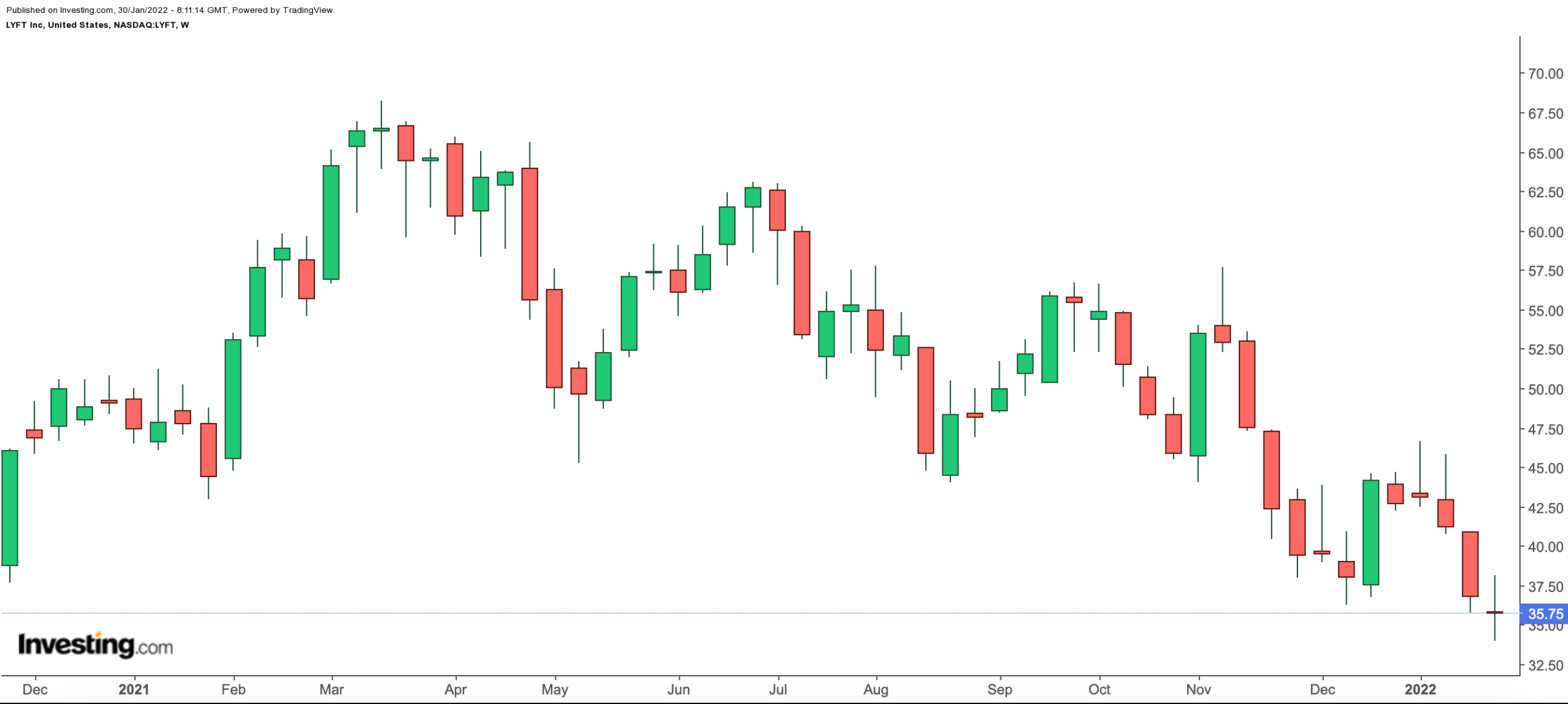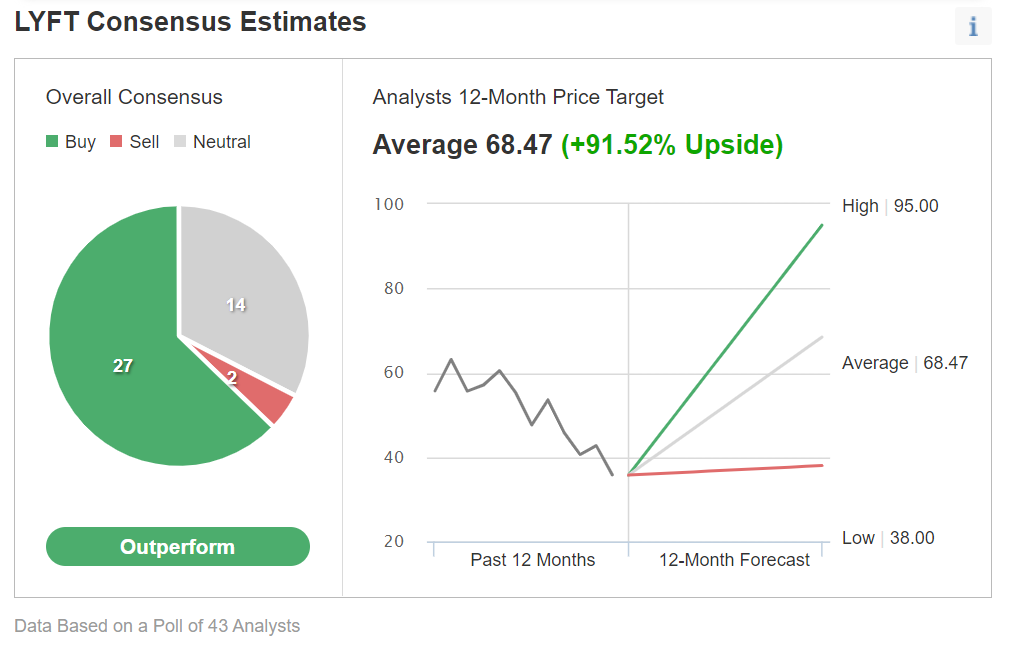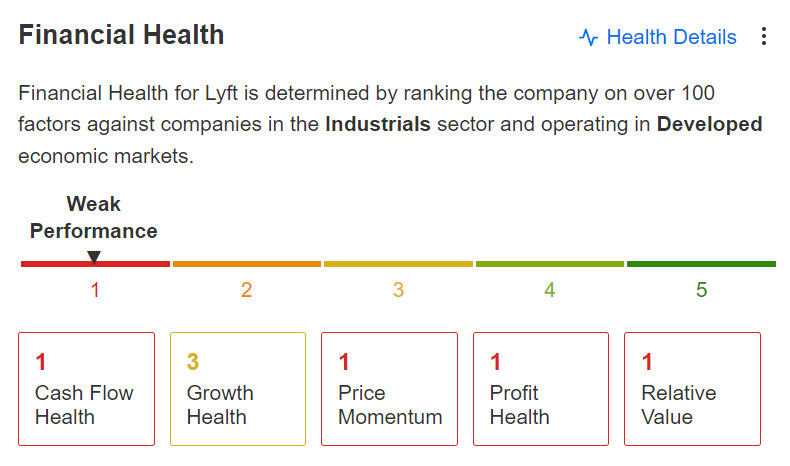- Ride-hailing company LYFT stock declined over 16% in January.
- As Lyft reports Q4 earnings on Feb. 8, shares are likely to be choppy.
- Long-term investors could consider investing around current levels.
- ProShares On-Demand ETF (NYSE:OND)
- ETFMG Travel Tech ETF (NYSE:AWAY)
- SPDR S&P Transportation ETF (NYSE:XTN)
- Vanguard Mid-Cap Index Fund ETF Shares (NYSE:VO)
Shares of the ride-sharing platform Lyft (NASDAQ:LYFT) have declined 16.3% since the start of 2022. In comparison, its biggest rival Uber (NYSE:UBER) is down 16.0%. At the same time, the Dow Jones Transportation Average dropped 8.7% in January.

What a difference a year has made in share prices of some of these former Wall Street darlings. On Mar. 18, 2021, LYFT stock pushed past $68 and hit a record high.
More recently, however, on Jan. 28, 2022, the stock saw a 52-week low just shy of $34, and closed the week at $35.75. The 52-week range has been $33.94 - $68.28, while the market capitalization (cap) of Lyft stands at $12.2 billion.
In the US, Lyft and Uber dominate the ride-hailing market with market shares of about 30% and 70%, respectively. Both companies came under significant pressure in 2020, especially in the early months of the pandemic when lockdowns were in effect.
As the vaccination rollout picked up steam in 2021 they both reported increasing levels of revenue. Yet long-term investors have been hesitant to keep these two stocks in their portfolios. As a result, LYFT lost almost 20% in the past 12 months and UBER stock declined over 30%.
Now investors are wondering what might be next for both names. Today’s article takes a closer look at Lyft shares.
Lyft’s Q3 Results
Lyft released Q3 financials on Nov. 2. Revenue of $864.4 million increased 73% year-over-year (YOY). A year ago, it had been $499.7 million in Q3 2020, an increase of 73% YOY.
The ride-hailing heavyweight had over 18.9 million active riders during the quarter, up from 12.5 million a year ago. Meanwhile, revenue per active rider reached $45.63. In Q3 2020, it had been $39.94.
Adjusted EBITDA for the quarter was $67.3 million, marking the company’s second consecutive profitable quarterly adjusted EBITDA. Finally, adjusted net income was $17.8 million. A year ago, it had been -$280.4 million.
On the results, (now former) CFO Brian Roberts cited: “In Q3 we achieved record Revenue Per Active Rider as ride frequency increased. We also hit a new all-time high Contribution Margin…”
Lyft will report Q4 results on Tuesday, Feb. 8 after market close. Management expects Q4 revenue will be in the $930-$940 million band and its adjusted EBITDA to be between $70 and $75 million.
Prior to the release of Q3 results, Lyft stock was around $45. A week later, by Nov. 10, it went over $57, and hit a multi-month high. But that price is now in the rearview mirror as LYFT shares currently change hands at $35.75.
What To Expect From Lyft Shares
Among 43 analysts polled via Investing.com, LYFT stock has an “outperform" rating.

Chart: Investing.com
Analysts also have a 12-month median price target of $68.47 for the stock, implying an increase of about 91% from current levels. The 12-month price range currently stands between $38 and $95.
On the other hand, according to a number of valuation models, like those that might consider P/E or P/S multiples or terminal values, the average fair value for LYFT stock via InvestingPro is $41.35.

Source: InvestingPro
In other words, fundamental valuation suggests shares could only increase around 15.5%.
We can also look at Lyft’s financial health as determined by ranking more than 100 factors against peers in the industrials sector.

Source: InvestingPro
In terms of cash flow, profit, relative value and price momentum, Lyft scores 1 out of 5. As a result, its overall score of 1 points to a weak performance ranking.
At present, Lyft stock’s P/B and P/S ratios are 8.2x and 4.3x. In comparison, those metrics for its peers stand at 2.4x and 2.4x. And the numbers for Uber are 4.9x and 4.6x. Put another way, despite the recent correction in Lyft stock, it does not necessarily offer great value, yet.
However, recent research highlights:
“The ride sharing market size is expected to be worth around $344.4bn by 2030 and is growing at a compound annual growth rate (CAGR) of 16.7% from 2021 to 2030.”
Therefore, we can expect long-term investors to take advantage of the significant declines in shares of both Lyft and Uber. But in the coming days, as Lyft gets ready to release Q3 financials, the stock could still be choppy and come under further pressure.
Adding LYFT Stock To Portfolios
Lyft bulls who are not concerned about short-term volatility could consider buying into the declines. Their target price would be $41.35, which is the fair value indicated by InvestingPro.
Alternatively, investors could consider buying an exchange traded fund (ETF) that has LYFT stock as a holding. Examples would include:
Finally, investors who believe the decline in LYFT stock will come to an end soon might consider selling a cash-secured put option—a strategy we regularly cover. As it involves options, this set-up is not appropriate for all investors.
Cash-Secured Put Selling With LYFT
Such a bullish trade could especially appeal to those who want to receive premiums (from put selling) or to possibly own LYFT shares for less than their current market price at $35.75.
This strategy may be appropriate when investors are slightly bullish or neutral on Lyft stock at this time. Selling cash-secured put options on LYFT would generate income as the seller receives a premium.
For instance, if investors sold the $32.50 strike put that expires on Mar. 18, they could collect about $2.05 in premium. Therefore, the maximum return for the seller on the day of expiry would be $205, excluding trading commissions and costs, if the option expires worthless.
But if the put option is in the money (meaning Lyft stock is lower than the strike price of $32.50) any time before or at expiration on Mar. 18, this put option can be assigned.
The put seller would then be obligated to buy 100 shares of Lyft stock at the put option strike price of $32.50 for a total of $3,250 per contract. In that case, the trader ends up owning Lyft stock for $32.50 per share.
If the put seller gets assigned LYFT shares, the maximum risk is similar to that of stock ownership (in other words, the stock could theoretically fall to zero) but is partially offset by the premium received ($205 for 100 shares).
The break-even point for our example is the strike price ($32.50) less the option premium received ($2.05), i.e., $30.45. This is the price at which the seller would start to incur a loss.
Cash-secured put selling is a moderately more conservative strategy than buying shares of a company outright at the current market price. This can be a way to capitalize on any choppiness in Lyft stock in the coming weeks, especially around the earnings release.
Investors who end up owning LYFT shares as a result of selling puts could further consider setting up covered calls to increase the potential returns on their shares. Thus, selling cash-secured puts could be regarded as the first step in stock ownership.
Bottom Line
Shares of the ride-hailing group Lyft are well off the record high of $68.28 seen in March 2021. Wall Street has not been fully convinced that Lyft is likely to put the pandemic behind it easily in order to recreate robust shareholder value.
January has been a down month for broader markets, including growth shares. As a result, Lyft stock now offers better value for long-term investors. Therefore, interested readers with a two- to three-year time horizon could consider buying the dip in LYFT shares.
